The Children's Floor - The Maid's Rooms
Living Quarters for the Female Personal Staff
 Left: Second floor plan, right side of the corridor on the Children's floor showing the Maid's rooms.
Left: Second floor plan, right side of the corridor on the Children's floor showing the Maid's rooms.
Room 29 - Maid's Bathroom
Palace maids supported the Tsarina and her children. They had rooms on the upper floor of the palace across from the children's rooms. There were foreign born maids who came with Alexandra to Russia and Russian ones. They were paid out of Alexandra's private accounts and they were managed directly by her. None of Alexandra's maids was married and she kept them apart from the rest of the servants and away from the general public and the press.
About the Empress's maids Anna Vyrubova wrote:
The chief maid of the Empress was Madeleine Zanotti, of English and Italian parentage, whose home before she came to Tsarskoe Selo was in England. Madeleine was a was a woman of middle age, very clever, and as usual with one in her position, inclined to be tyrannical. Madeleine had charge of all the gowns and jewels of the Empress, and as I think I have related, she was often critical of her mistress's indolent habits in regard to correspondence, etc. A second maid was Tutelberg, "Toodles," a rather slow and quiet girl from the Baltic. She and Madeleine were mortal enemies, but they agreed on one thing at least, and that was that they would not wear caps and aprons. The Empress good-naturedly acquiesced and permitted simple black gowns and ribbon bows in the hair for her chief maids. There were three under maids, all Russians, and all perfectly devoted to the Imperial Family. These girls, who wore the regulation caps and white aprons, cared for the rooms of the Empress and the children. All the maids, when the Revolution came, remained faithful to the family, and one of them, as I shall tell later, performed the dangerous service of smuggling letters in and out of Siberia. One girl, Anna Demidova, shared the fate of the family in 1918."Baroness Sophie Buxhoeveden, a Lady-in-Waiting to the Empress, has written the following about the relationship of Alexandra to her maids:
"She took interest in the lives of all her Household, from the Grande maitresse down to the last little maid, often helping the humble ones and their families in ways that no one knew. She was democratic in the real Christian sense, and made no distinction of class. She would go to see a sick maid as readily as one of her ladies-in-waiting. During the terrible time of her captivity at Tobolsk she remembered that her faithful maid, Madeleine Zanotti, had been with her for twenty-five years. She contrived to have a little present made, and begged the commander to send it to her on that anniversary. Though she was naturally hot tempered, the Empress seldom gave way to irritation. When greatly provoked, she would flare up, but she would be much distressed at her hastiness, and would worry for days about a small thing, which had probably been forgotten by the person who had incurred her displeasure. The forgiveness which, in accordance with the Russian custom, she begged of those round her before going to confession was really asked for from the heart."
The maids had two bathrooms on the children's floor. One was on the mezzanine level above Alexandra's bathroom. This was the second bathroom. It was painted light green and had chintz wall covering and curtains. There was a large enamelled iron tub and the floor was covered with glazed tiles. The room had furniture painted in ivory-colored enamel. The room also had an ironing board and an electric iron for the maids to touch-up their own garments.
Since the bathroom was shared by six women bathing times were set by schedule. The maids took daily baths of 40 minutes duration and each maid had her own key to this room. Water for the tub came from the basement boilers. The maids came to the bathroom along the children's corridor from their nearby rooms dressed in their robes. The head maids usually had their junior maids to assist them in preparing their bath. Junior maids fended for themselves when their time came.
Room 30 - Room of Maid Elizabeth Ersberg
Ersberg was one of Alexandra's personal maids and she came with the Empress from Hesse-Darmstadt. Ersberg was German, but she and the Empress spoke English with one another.
Each maid's room was partitioned into a vestibule, sleeping room and washroom. The walls of Ersberg's suite were covered in a grey straw-colored wall paper and it was furnished with mixed furniture in polished beech-wood and mahogany. Ersberg's nickel-plated bed had a spring mattress. The room had cotton chintz curtains printed with garlands of roses with ribbons and a soft moss-colored carpet. The soft furniture in the room was covered with the same material. The room's washstand had a marble top and had hold and cold running water. In a corner hung an ikon of "Our Lady of Tsarskoe Selo". Heat was provided by a tiled dutch stove and a portable Finnish tiled stove in the suite's vestibule.
Ersberg travelled with the Imperial family to Tobolsk.
Room 31 - Room of Maid Anna Yakovlevna Utkina
Utkina worked with the children. Her room was similar to Ersberg's except it had a large double sink and the bed was of bronzed-iron. While Alexandra's maids spoke English in the palace, the Empress hired Russian maids to assist her children in their native language. Utkina assisted the head-Russian maid Tegleva.
Utkina went with the family into exile to Tobolsk.
 Right: Anna Demidova
Right: Anna Demidova
Room 31 - Room of Head Maid Alexandra Alexandrovna Tegleva
Tegleva's room had walls covered by light yellow cotton cretonne and their was a frieze under the covered ceiling. The furniture of this room was of birch and mahogany. Above Tegleva's bronzed-iron bed were hung ikons. Other paintings on the walls were watercolors by Russian artists, Volkov, Derevenko and others. She also had a hung on the walls photographs of the Imperial family and their yacht "Standart". Her wardrobe in the vestibule of her suite was full of fine clothes left behind when Tegleva left the palace during the summer of 1917. Most servants removed their personal belongings after the Romanov's were exiled to Tobolsk. It doesn't appear that Tegleva did so; her tables were covered with personal effects such as photographs of her fellow employees and the Imperial family that she left behind. Of note was a signed photograph of Grand Duchess Olga and photos of Aleksey and Maria as children. Above the table was a maple cabinet full of small shoes and socks given her as momentos by the children. On Tegleva's writing desk were found photos of Alexandra, Anastasia and other snapshots of the family.
Tegleva went to Siberia with the Imperial family and later married the Tsarevich's tutor, Pierre Gilliard. She left Russia with him and settled in Switzerland.
Room 32 - Room of Zanotti's Assistant Maid, Elizabeth Eltser
This room was divided into two parts by a tall gray-painted partition. Matching gray Art Nouveau wallpaper was hung on the other walls and the floor was of parquet without carpet. The Karelian-birch furniture in the room was in the Empire style and dated from the era of Nicholas I. Eltser's bed was gilded and had a French mattress. A large screen covered in English chintz printed with roses and ribbons brightened the room and the window curtains were made of bright cretonne. In the antechamber of the suite was a sitting bath, a washstand and a large basin.
Room 34 - Room of Alexandra's Maid on Duty
This was a day room for the Maid-of-Honor to rest in while on duty. The Lady-in-Waiting's normal rooms were on this floor on the opposite side of the palace. It was too far to go if she was needed by the Empress so this room, which was much closer to Alexandra, was reserved for their use duirng the hours they were officially on duty. It was furnished like the maid's rooms and the bed here was of painted iron with a cretonne bedspread. The furniture was of mahogany. All of these rooms had buzzers connected to the Empress's rooms so she could call on her staff as needed.
Room 35 - Room of Kammer Youngferin Zanotti
Madeleine Zanotti was of Italian and English parentage and she spoke English, Italian and German fluently. She came to Russia with Alexandra at the time of the Empress's marriage from England. Zanotti brought Alexandra's terrier, Eira, to Russia and she had pictures of the dog in here. Her room was separated in two parts by a wooden partition that did not reach the ceiling; one side was a sitting area and the other was her edroom. Zanotti's furniture was a mixture of Russian Empire pieces in mahogany and soft chairs covered in colorful cottons. Her windows were covered with two drapes, the inner being of dark green cloth and the outer of cotton cretonne. On the floor was spread olive-colored Axminster carpet woven with laurel branches with ribbons. Ikons were hung above Zanotti's bed. A large copper bath allowed Zanotti to bathe privately. She also had a private toliet-closet in her room..
All of the maids had writing desks and their rooms also had bronze lamps and collections of porcelain and glass. Many of these were gifts from the family. Zanotti had a big Black Forest Cuckoo-clock in her room and various other things from Germany.
Of interest in Zanotti's room was her revolving book stand which held a wide array of volumes from a German hymn book to Oscar Wilde's "De Profundis". On the walls were a large nnumber of watercolors and oills which were selected by Zanotti according to her own taste.
When the Imperial family was exiled to Siberia Zanotti did not leave for Tobolsk immediately, but stayed in the palace to take care of the Empress's things. In November she travelled to Tobolsk with two of the Empress's maids, but they were refused entrance to the Governor's Mansion where the Imperial family was being held. From time-to-time the family was able to see Zanotti from the windows of the mansion as she walked in the street in front of the building. Zanotti and the other maids stayed in Tobolsk, but after a number of months made their way from Russia. Only one, Anna Demidova, stayed with the family until the end.
When, in November, the Empress's dresser, Madeleine Zanotti, and two maids arrived from Tsarskoe Selo, they were not admitted, though they had the necessary authority from Kerensky.
Room 36 - Room of Kammer Youngferin Marie Tudelberg
The furniture in Tudelberg's room was in Russian Empire style from the reign of Nicholas I and the decoration was similar to Zanotti's. Among the paintings on the walls was a watercolor by Anastasia of roses dated 25 May 1914 and a watercollor painted by Grand Duchess Olga Alexandrovna dated 1903. Room 37 - Classroom of the Younger Grand Duchesses
This room was over Nicholas's Reception Room and the piano practice of his daughters could be heard from above in this room.
Bob Atchison




 Imperial Bedroom
Imperial Bedroom Portrait Hall
Portrait Hall Mauve Room
Mauve Room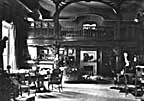 Maple Room
Maple Room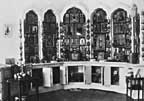 Aleksey's Bedroom
Aleksey's Bedroom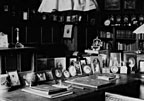 Nicholas's Study
Nicholas's Study Aleksey's Playroom
Aleksey's Playroom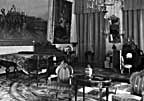 Formal Reception
Formal Reception Balcony View
Balcony View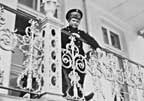 Aleksey- Balcony
Aleksey- Balcony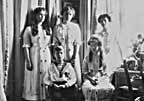 Children-Mauve
Children-Mauve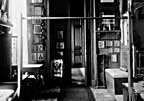 Nicholas's Bathroom
Nicholas's Bathroom Alexandra- Mauve
Alexandra- Mauve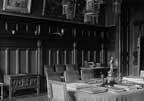 Nicholas's Reception
Nicholas's Reception Tsarskoe Selo Map
Tsarskoe Selo Map